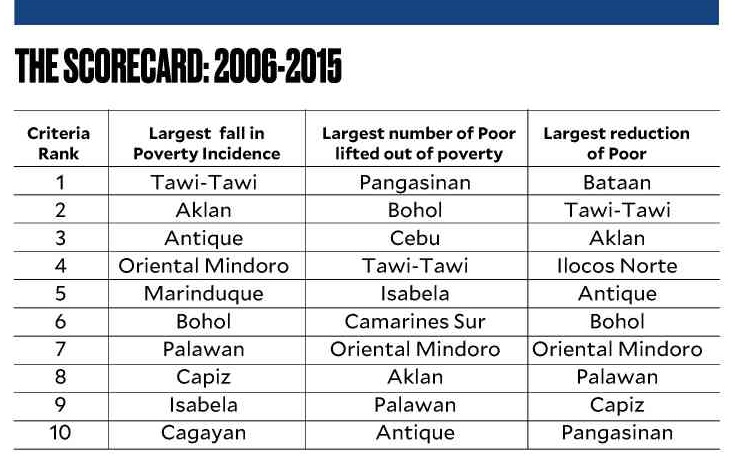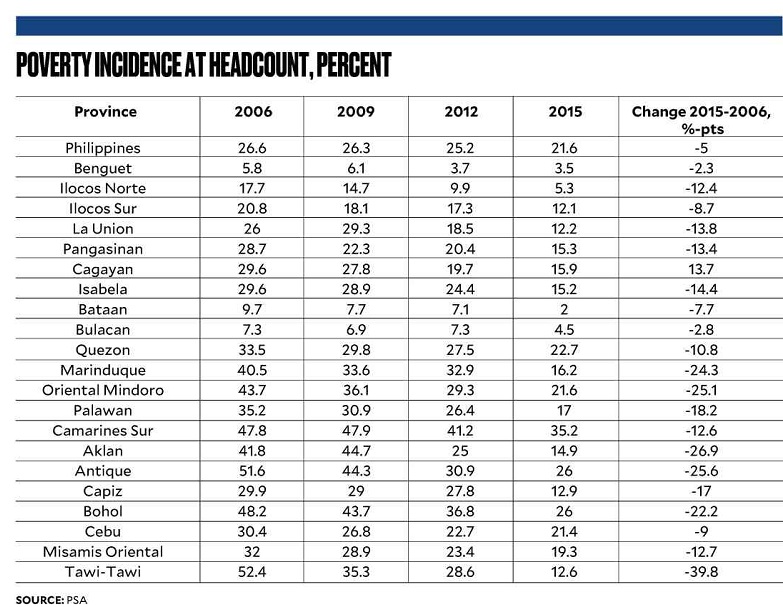Leading provinces in reducing poverty
Which province performed well in poverty reduction? Many will be in for a surprise!
Poverty reduction is inclusive growth. During the past 10 years, Philippine incidence slowly fell from 26.6 percent in 2006 to 21.6 percent in 2015. Interestingly, there are many provinces that outperformed the national record.
The analytics considers only provinces which consistently posted a decline in poverty every survey period from 2006 to 2015. Among the 78 provinces, 20 provinces qualified.
Note: La Union had a significant reduction during the period but it was excluded as it posted a jump in poverty incidence in 2009 from 2006.
In ranking the provinces, the three criteria were: (a) percentage fall in poverty incidence, (b) largest number of people lifted out of poverty, and (c) largest decline in number of poor.
Star performers
Article continues after this advertisementTawi-Tawi, a province in the poorest region, ARMM, surpassed all provinces. Among the top five are Aklan and Antique in Western Visayas, and Oriental Mindoro and Palawan in Mimaropa.
Tawi-Tawi is far ahead with an almost 40 percentage-point fall in poverty incidence between 2006 and 2015. The next four are: Aklan, Antique, Oriental Mindoro and Palawan.
In sixth to 10th places are: Bohol, Palawan, Capiz, Isabela and Cagayan.
Largest number lifted out of poverty
Pangasinan (-328,600) led, followed by Bohol (-246,000), Cebu (-198,000), Tawi-Tawi (-161,000) and Isabela (-155,000).
Completing the top 10 are: Camarines Sur, Oriental Mindoro, Aklan, Palawan and Antique.
Largest percentage decrease in number of poor
Bataan topping the list is a surprise at -74.5 percent. It is followed by Tawi-Tawi (-72.7 percent), Aklan (-67.5 percent), Ilocos Norte (-65.2 percent) and Antique (-50.9 percent). These are outstanding performances compared to the Philippine record of -3.2 percent!

The case of Mindanao
Mindanao did not fare well: the number of poor rose by 7.5 percent or over 600,000. Of the six regions: three added more poor: Northern Mindanao, Soccsksargen and ARMM. Three reduced them: Zamboanga, Davao and Caraga. Of the 25 provinces, 10 posted rising numbers of poor during 2006-2015.


With respect to Tawi-Tawi, a Mindanao expert, Dr. Fermin Adriano says: “The reason for its good performance is the entry of cheap rice and other commodities from neighboring Sabah to the island. Which any way proves my point that if we liberalize rice trading, we will be able to reduce the grain by almost half of its Manila prices. Other basic commodities being brought in are petrol, sugar, vegetable oil, etc.
The other major reason is because the illegal migrant Filipino workers coming mostly from the three island provinces (i.e., Tawi-Tawi, Sulu and Basilan) send their remittances to their family and relatives back to the provinces. An indicator that the remittance amount is substantial is that during Saturdays (day-off of workers), the Malaysian ringgit artificially becomes more expensive, fetching fewer pesos when converted to pesos remitted to the Philippines.”
Takeaways
What could be the qualitative factors for dramatic poverty reduction of some provinces, and none for the others?
My “gut feeling” tells me the following:
Economic opportunities: Tawi-Tawi (border trade), Aklan, Palawan, Bohol (tourism);
Remittances: Antique, Marinduque, Bohol;
Productive agriculture: Ilocos, Cagayan and Isabela; and
Good provincial and municipal governance.